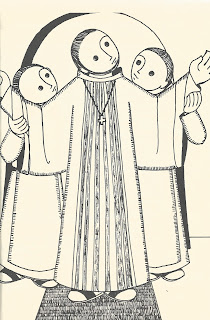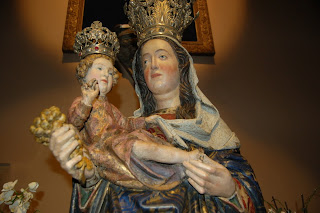- thanks for the sermon 'like a Power Point Presentation'.
- thank you for 'a marathon sermon'.
- created an interesting picture.
----- Forwarded Message -----From: William j.
To: Donald......>
Sent: Thursday, 11 July 2013, 14:06
Subject: St. Benedict 'Father of Europe' soliloquy
To: Donald......>
Sent: Thursday, 11 July 2013, 14:06
Subject: St. Benedict 'Father of Europe' soliloquy
- Dear Father Donald,
Thank you for sending me a copy of your soliloquy - a real joy!You take us with you into Monte Cassino and bring it alive - your experiences!I googled the Basilica, fascinating....... in Our Lord,William
Tuesday 11th July 2013
Our Holy Father Benedict, Abbot, Patron of Europe.
Our Holy
Father Benedict chapter sermon 11 July 2013. Fr. Donald
If you have at least two thoughts, you
are not empty headed, or something the GK Chesterton said.
On the other hand, one picture is worth
1,000 of words.
Adorning along our NUNRAW
cloister is a picture
of Our Holy Father Benedict, Abbot,
Patron of Europe.
There is a signature by Pietro Annigoni,
the outstanding artist.
One picture brings to another picture,
one from a cloister in Nunraw, and a second to a cloister in Montecassino.
...
The
picture in the cloister is but a tip in iceberg – the tip of the Pietro
Annogoni mighty fresco of ‘The Glory of
St. Benedict’ in Monte Cassino, and the tip of the Basilica of Monte
Cassino.
The
picture in the cloister has a signature of the artist but it is something of a
‘Jock’s bairn as to where it comes from
Possibly
it was my doing, that on the occasion of 15th centenary of St.
Benedict 1980 I may have brought portrait from Rome.
To
unravel the story.
In
1980, all the Benedictine and Cistercian Abbots were gathered at Monte Cassino
with Pope John Paul II. All the Abbots each had their pictures with the Pope –
the Blessed John Paul was better at shaking hands better at children than with
Lord Abbots.
In
the Basilica we assembled for celebration of the Mass under the glorious dome.
I
photographed, with the old non-digitised camera, some shots; all to my
unawareness of the splendours above us.
 |
| Poverty |
During
this week, researching for the Chapter Sermon on St. Benedict opened up the
Pietro Anngoni frescos of the Dome. With the benefit if digital technologies we
can view the details of the painting of Annigoni. From the four of the pillars supporting
the arches, the artist illustrates the Benedictine rock-bed tradition of the four vows, Chastity, Obedience, Poverty
and Stability.
His are the frescoes in the dome
and the four pillars where are represented the four vows that bound by
the monks
Poverty represented by monk with the cross in his right hand and giving
the money
- The obedience represented by listening monk
- monk stability represented by holding the anchor
On
the scale of the decoration of the interior of the Basilica must have been the
largest contributor to the work.
The
most outstanding part of it is the magnificent 40 metres fresco of ‘The
Glory of St. Benedict’.
What,
we have in our cloister, is merely the head portrait of Benedict extracted from
the whole panorama.
The
greatest significance of Annagoni and Monte Cassino was the historic dedication
of the completion of the restoration of the Basilica.
The
dedication was by Pope Paul vi on 1964.
Prior
to painting of the fresco of ‘The Glory of St. Benedict’ with the heavens and
angels and, below, Saints and Popes and Bishops, Abbots, monks and lay people,
centre at the bottom are
The grand fresco
by Pietro Annigoni (in fact the Glory of
St. Benedict) that an area of over 40 square meters stands on the back wall
of the church (photo below) and that was painted in 1978, the last year of the
pontificate of Paul VI.
The devout crowd
that encircles the Saint, the appearance
of some leading personalities of the last century that are known by the same
Annigoni: Pius XII and John XXIII at the sides of the Holy , and at the bottom
center, next to Paul VI with the statesman Alcide De Gasperi, one of the main
architects of the Italian Renaissance after the war.
In the fresco are identified in the foreground three Popes: - right
Pope Gregory the Great - Pope Paul
VI at the center - left Pope Victor III already Abbot Desiderius
(Annigoni
himself died 1988).
(Pietro Annigoni
(June 7, 1910 - October 28, 1988)).
+++++++++++++
Cloister
Talking
of the tip of the iceberg of the events, Monte Cassino itself was something of a
miracle. It was mostly destroyed by the 2,500 bombs blitz by the Allies of 2nd WW.
Something
parts survived underground.
With
the associations of cloisters, in Monte Casssino the significant statuary of
St. Benedict was saved. The description of St. Gregory depicts the death of St.
Benedict. Two of disciples support him
dying after his last Communion.
+++++++++++++
Timely and apt at this feast.
The
Sisters from Spain, St. Regina (Text) and Sr Lourdes. (Illustration)
beautifully re-echoes the very thought of St. Benedict on death. The very simple
illustration by Sr. Lourdes reflects the same scene.
Death
Then, St Benedict, supported by two brothers, was
carried to Choir for the last time, to celebrate his most solemn Profession,
his greatest act of worship. For death is the most holy liturgy of adoration a
monk can offer.
It was Holy Thursday of the year 547.
Standing before the altar he prayed like
this:
"Lord, Jesus.
This is the hour of the great meeting,
Of the truly Holy Communion,
Of Love right to the end.
Henceforth I shall be a true monk like
you,
Fully, forever,
Always living to intercede for the
world.
Today is the day
When you have given me your Body
And your Blood.
I offer you this poor body of my flesh.
Receive it according to your promise
And I shall live.
Let me not be confounded
Since it is in you I trust.
Come, Lord Jesus. Amen."
And leaving this world, the Blessed Father went to sit
down at the Feast of the Great Holy Thursday in the Kingdom of God.
(Our Father Benedict, Published in Spain
by Pulsations de l’Abadia de Montserrat 1980)
+++++++++++++
It
is a timely conclusion on this solemnity thought of St. Benedict, Patron of
Europe, not another picture but a sculpture.
In
1880, Sr. Concordia of Minster Abbey, sculpted the “Father of Europe”. She
wrote the accompanying note, “The medallion on St. Benedict’s ‘neck’ is the
symbol for European Unity – 12 stars around a cross -.” ...
It
was Pope Pius xii who named St. Benedict “Father of Europe”, no doubt Sr.
Concordia learned the title here for her sculpture.
Summing
the pivotal words in Paul VI’s Apostolic
Letter, Pacis Nunntius at Mont Cassino, 1964
“And in the
light of this solemn proclamation, today’s date appears to Us particularly
appropriate, for on this day We re-consecrate to God, in honor of the most holy
Virgin and St. Benedict, the temple of Montecassino, which having been
destroyed in 1944 during the terrible world conflict, was reconstructed through
the tenacity of Christian piety.”
A
very memorable 20 years, 1944 to 1964 and the blessing of St. Benedict , the Principle
Patron of All of Europe
When
the man of God was keeping watch and praying, he saw the whole world gathered
as though into one sunbeam. (Dialogues
2:35)
Gloria.tv: Monte Cassino reconsecrated by pope Paul VI 1964.
en.gloria.tv/?media=161018
May 26, 2011clicks. 5,896. Links. 4. Monte Cassino reconsecrated by pope Paul VI 1964. frater_pl 26/05/2011 13:25:43 ...
 |
| Pius xii - San Benedetto -John xxiii |

















